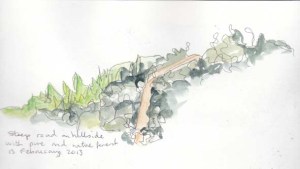While in Adelaide I saw the Turner from the Tate exhibition at the Art Gallery of South Australia, closing 19 May. This exhibition will open in Canberra at the National Gallery of Australia on 1 June.
The visitors numbers were reasonable so we were able to have a really good look at the works. Much to my surprise you were allowed to take photos in the exhibition as long as you didn’t use a flash (don’t expect such liberties in Canberra). Here is Turner’s paint box.

Turner’s paintbox – pigs bladders for carrying mixed pigments at the top of the box and jars of ground pigment at the front
The rounded shapes at the top are the pigs bladders in which the mixed pigments were carried.
What I really enjoyed about this exhibition was the number of studies and sketches that were included. I am intrigued by the Turner’s process, particularly his watercolours. Some of were titlted “A Beginning” and were colour studies or pieces left almost as soon as they were started.
If you want to see more of this type of work the Tate Gallery (holders of the Turner Bequest) have digitised Turner’s sketchbooks. If you look at the Turner’s Finberg sketchbook you will see many colour studies which to our contemporary eyes look like abstract works. In these works there is only an occasional figure or recognisable shape emerging from the picture. No wonder Turner’s contemporaries had trouble understanding these works.
Whenever I go to an exhibition I like to play the game of “if I could take one piece from this exhibition …” . For this exhibition my number one pick would be this triple seascape study, Three Seascapes, c 1827. What is interesting is that the painting also works when it is turned upside down. The dark section at the top becomes the land and the centre section’s sea and sky for become reversed for the lower section of the work. I wonder did Mark Rothko ever see this work?
The works in the exhibition are drawn from the Turner Bequest to the Tate Gallery. If you want to see more the Tate has digitised the bequest so you can look at your leisure, that is as long as you have plenty of time to look (when I checked it showed over 2,000 pages of work)!











